
March 2015
Ayotzinapa: To Get
Justice, Fight for Socialist Revolution
Massacre in Mexico: It Was the Murderous Capitalist State
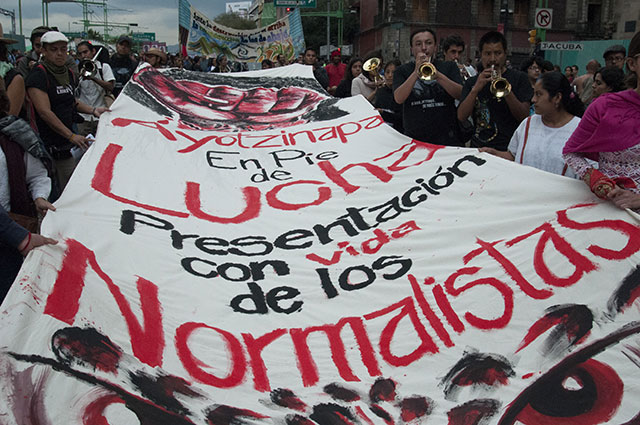
Students march in Mexico City on 2 October 2014 to commemorate the martyrs of the 1968 Tlatelolco massacre and to demand that the 43 teachers college students from Ayotzinapa be returned alive. (Photo: Cuartoscuro)
Constituent Assembly – A Bourgeois
Trap
For a National Strike On the Road to
a Workers and Peasants Government!
Forge a Revolutionary Workers Party!
The following article from February 2015 is translated
from Revolución Permanente, the newspaper of the
Grupo Internacionalista of Mexico.
MEXICO CITY – For the last four months, the streets of Mexico have resounded with hundreds of thousands of anguished voices exclaiming, “They took them from us alive, we want them back alive!” They are demanding the return of the 43 students of the Ayotzinapa Rural Teachers College kidnapped last September 26. They demand “Justice!” But how to get it? For sure not by begging the murderers, among whom we count the rulers at all levels, as well as those who profit from the oppression of the working masses.
“It was the state!” they cry out, hoarse from repetition, rightly rejecting the claims of the authorities who want to wash their hands of the affair by blaming a two-bit drug trafficking cartel. “Down with [Enrique] Peña Nieto!” they demand, making it clear that the Mexican president and his PRI (Institutional Revolutionary Party), like the PRD (Revolutionary Democratic Party) governor of the state of Guerrero bear personal and institutional responsibility for the killing in Iguala. But only them? Behind this atrocious crime there is a whole, bloody system: capitalism.
For the massacre of the teachers college students is no
anomaly, above all in this country [Mexico] that in recent
years has seemed like a horror film that never ends. Recall
the hideous massacre of 45 Indians, members of the Las Abejas
Collective in the municipality of Chenalhó (Chiapas) in 1997.
Or the spine-chilling discovery of the bodies of 72
undocumented migrants in an empty field in San Fernando,
Tamaulipas in 2010, or after that the second massacre of San
Fernando when another 193 people were killed in 2011. Or the
recent execution of 22 “suspects” by the Army in Tlatlaya
(Mexico State) last June. And above all, the 100,000 people
murdered and more than 20,000 disappeared since 2006 in the
“war on drugs.”
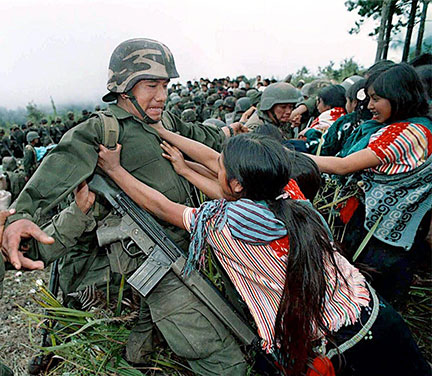
Tzotzil indigenous women confront the Mexican army after the massacre of Acteal, in Chenalhó, Chiapas, December 1997. (Photo: Pedro Valtierra/La Jornada)
“What of it?” is the response of the federal government, expressing its haughty disdain for the unwashed masses by shelving the case of the dead and disappeared of Ayotzinapa. Just as the Argentine government tried to hide its dirty war of the 1970s behind an “official story,” the arrogant Mexican regime proclaims its unappealable “historical truth”: “it was the narcos” (drug traffickers) who kidnapped and massacred the students, it decrees. “It was not a state crime,” the criminal state insists. And it continues to follow its bloody path: a “shootout” on January 6 in Apatzingán (Michoacán) left a toll of 13 dead; teachers college students who protest on the Autopista del Sol (Highway to the Sun) superhighway to obtain justice for their comrades are kidnapped by thefederales.
In spite of their disdain and feigned calm, “those on top” are quite worried about the unrest among “those on the bottom.” The Tierra Caliente (hot land) of Michoacán is still aflame, despite the arrests of dozens of “autodefensas” (self-defense forces) who had become uniformed “rural guards.” Now the state is a battlefield between the cartel of the Caballeros Templarios (Templar Knights), which was favored by the previous PRI state government, and another gang, Los Viagras (linked to the Jalisco Nueva Generación cartel) which currently enjoys the approval of the federal government’s “commissioner,” who is now a top-level military officer.
For its part, the state of Guerrero is a “bonfire” (as Luis Hernández Navarro wrote in La Jornada, 3 February), with an interim governor and state office buildings burned down in October. On January 12, parents and students from Ayotzinapa searching for their children and fellow students clashed with hundreds of military police inside the grounds of the 27th Infantry Battalion in Iguala. Meanwhile, more than 30 city halls have been taken over by the Guerrero People’s Movement (MPG), whose participants include the Ayotzinapa teachers college students, peasants and dissident teachers of the CETEG.1
Mayors are on the run, after being expelled from the
municipalities for corruption. They roam the state like
nomads; in Acapulco, the government pretends to operate out of
meeting rooms in the luxury hotels of the port city (“Twilight
of the Mayors,” Milenio, 3 February). In several
places, “popular municipal councils” have arisen, and in the
regions of La Montaña and Costa Chica, the rival community
police of the CRAC, UPOEG and now the FUSDEG proliferate.
Everywhere in Guerrero, walls are painted with the slogan,
“There Will Be No Elections on June 7” until the 43 students
are returned.
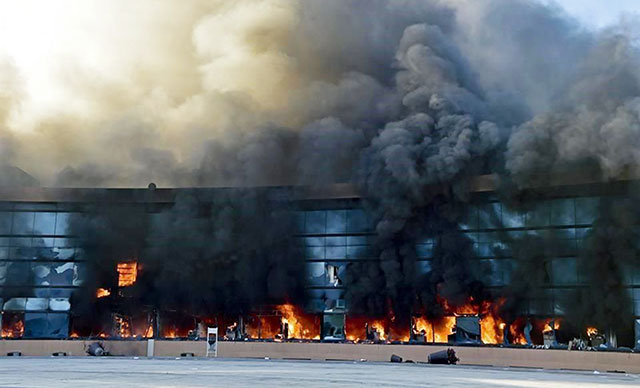
Guerrero state government offices in flame after being besieged by hundreds of students and teachers furious over the Iguala massacre and the role of the government, 13 October 2014. (Photo:AFP)
The bloodbath and mass kidnapping of Iguala have thrown the life of the country into turmoil, plunging the government into the worst crisis of bourgeois “governability” in half a century. Vast sectors of the population feel outraged and shaken. The imperialist masters are worried as well: the main focus of Peña Nieto’s recent interview in the White House was “security” and the kidnapped normalistas, as the teachers college students are known. President Obama offers to send American “aid.” In short, the “Ayotzinapa case” is far from being a merely local, or even national affair.
Thus the Mexican edition of Forbes (January 2015), the American business magazine that calls itself the “capitalist tool,” published an in-depth article on Ayotzinapa and the rural teachers colleges. Meanwhile, the geostrategic consulting firm Stratfor has distributed analyses of the events in which it argues that “Normalista Unrest Highlights Mexico's Geographic Challenge” (October 2014) and “Mexico's Normalista Protests Threaten to Spread” (November 2014). They warn that:
“Despite President Enrique Pena Nieto’s efforts to surmount the country’s security problems through economic reforms and increased coordination of security forces, the federal government is struggling to maintain its authority. Mexico is seeing rising unrest among an increasingly disillusioned population, especially in southwestern states.”
The Grupo Internacionalista has insisted from the outset that the massacre was due to the onslaught against the Ayotzinapa students and the rural teachers colleges in general, which in turn is the product of an offensive aimed at privatizing education instigated by Washington and the imperialist financial institutions.2 In particular, as our comrades in the United States have stressed, it is the product of a policy of “Militarization in Mexico, Made in U.S.A.”.3
The federal government has opted to wait to let the protests run down and then crush the rebels, exhausted by so much mobilization, with overwhelming force. That is exactly what president Vicente Fox of the clerical-rightist National Action Party (PAN) did in Oaxaca in 2006. Now, following the announcement of the “historical truth” decreed by the attorney general Murillo Karam, the minister of the interior (gobernación) Osorio Chong commented to PRI senators in a closed session that the federal government had sent “as many forces of the Army, Navy and Federal Police as imaginable” to Guerrero (La Jornada, 30 January).
The repressor-in-chief of Bucareli (the street where the Secretariat of Gobernación is located) announced that he will not tolerate that groups “which have for a long time been recognized as radicals in Guerrero take advantage of the tragedy of Ayotzinapa in order to mobilize and commit excesses.” The murder of “radicals” has already begun. On February 4, the decapitated body of Gustavo Salgado Delgado, leader of the Revolutionary Popular Front (FPR) in the state of Morelos and an important organizer of the protests for Ayotzinapa, was found. The FPR rightly insisted that “this crime is part of a policy of terror carried out by the state.”
Despite the escalating repression, rather than concentrating on extending the rebellion to the workers of the entire country, the Guerrero rebels have retreated to their base. Currently there is a strike by teachers throughout the state over unpaid salaries (due to the educational “reform”), and on February 5 there were protests in Ayotzinapa in Guerrero, along with some marches in Chiapas and Michoacán, but not in the national capital. As combative as it is, an uprising limited to a few states in southwestern Mexico will not be able to resist the federal government’s onslaught.
Meanwhile, appeals are being made to the United Nations Committee on Enforced Disappearances in Geneva and to the Inter-American Court of Human Rights in San José, Costa Rica. These bodies, completely subordinated to the orders of U.S. imperialism, will never require the Mexican government to do anything that doesn’t have Washington’s stamp of approval. The same goes for human rights organizations like Amnesty International and Human Rights Watch, whose job is to denounce regimes that are on the U.S.’ black list, like Cuba, Russia or Syria.
The history of the “dirty war” in the state (see box) which unleashed a reign of terror there exceeding that in any other region of the country, demonstrates that the Mexican government will never tolerate a “Red Guerrero,” any more than in 2006 it permitted a “Oaxaca Commune,” despite the fantasies of some starry-eyed leftists. The dream of “heading into the hills” to launch a new guerrilla war is a policy of defeat. Mexico has had more rural armed struggles than any other Latin American country, yet all failed in the face of the vicious repression by the Mexican government and Yankee imperialism.
The repression of the Ayotzinapa students is not the result of local corruption nor of purely national policies. The assault on the rural teachers colleges is part of the plans of the imperialist financial agencies to regiment and privatize public education. It goes hand in hand with the “free trade” policies which have devastated Mexican agriculture. In short, the hunting down of the radical normalistas is the product of international capitalism, and to defeat it requires working-class mobilization in an international revolutionary struggle.
Workers Mobilization on the Road to Socialist Revolution
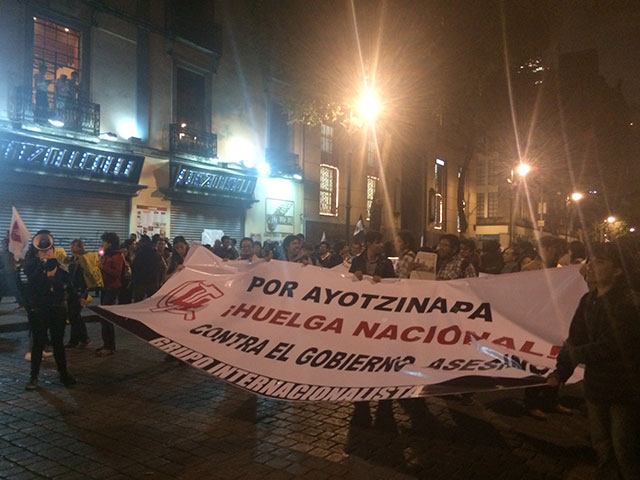
Contingent of the Grupo Internacionalista in the march to Mexico City’s Zócalo, 22 October 2014. Banner says: “For Ayotzinapa – For a National Strike Against the Murderous Government.” (Photo: Revolución Permanente)
What’s needed is a counteroffensive of the proletariat, at the head of the oppressed, against the bourgeois regime of hunger and repression. The combativeness of the normalista students and teachers of Guerrero has been exemplary, but it is necessary to extend it to the entire country, and above all to key sectors of the working class. The Grupo Internacionalista has agitated in numerous student and union assemblies, with student and worker brigades and distributing Marxist literature in the mass mobilizations, calling for a national strike against the murderous government, beginning with a strike of the education sector, in a fight for “a workers and peasants government to resolve the democratic tasks in the course of initiating and extending international socialist revolution.”
Around the world there have been solidarity protests in several dozen countries of the Americas and in Europe. Our comrades of the Internationalist Group in the United States organized the first emergency pickets at the beginning of October outside the Mexican consulate in New York, which were highlighted by the press in Guerrero. The IG emphasized that from Ferguson, Missouri, where the black youth Michael Brown was the victim of a racist police murder last August, to Ayotzinapa, it is one struggle. Our Brazilian comrades of the Liga Quarta-Internacionalista do Brasil (LQB) put forward a motion of solidarity with the teachers college students which was passed by the combative teachers and health workers unions of the state of Rio de Janeiro, and they held a protest outside the Mexican consulate in Rio last October 17.
In Mexico, the struggle for Ayotzinapa has convulsed the
country. There have been at least four national days of work
stoppages of 24, 48 and 72 hours in schools at different
levels. In Oaxaca, the militant teachers of Section 22 of the
CNTE stopped work and blocked the airports of Oaxaca and
Huatulco, along with the refinery of Salina Cruz. In Guerrero,
the teachers of the CETEG set up a tent city in the center of
Chilpancingo and have directed their anger at buildings
symbolizing the rotten bourgeois institutions: the governor’s
residence (October 29), the state congress (November 12 and
January 5), various government office buildings throughout the
last four months, and the 27th Infantry Battalion in Iguala on
January 12.
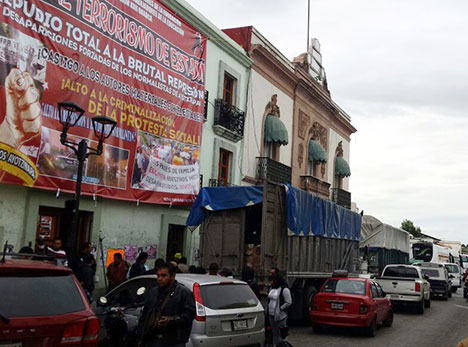 Section 22 of the CNTE loading
trailers outside union headquarters for a solidarity caravan
to Ayotzinapa, 15 October 2014. A national strike of the
entire education sector is urgently needed.
Section 22 of the CNTE loading
trailers outside union headquarters for a solidarity caravan
to Ayotzinapa, 15 October 2014. A national strike of the
entire education sector is urgently needed. (Photo: Revolución Permanente)
The bourgeoisie is desperately trying to turn the page and get past the issue. Speaking at the Imperial World Forum in Acapulco during a December 4 visit to Guerrero (in which he didn’t go to Ayotzinapa, Iguala or even Chilpancingo), Mexican president Peña Nieto called on the parents and schoolmates of the disappeared students to “get over [superar] this moment of pain.” (He promised hotel executives concerned about highway blockages that he would “protect free movement” on the superhighway with beefed-up police.) But the chief executive only managed to fan the flames of indignation. After the uproar in the social media over #YaMeCansé (I’m tired of it) picking up on the insulting words of the attorney general Murillo Karam, now there was an explosion of fury with the hashtag #YaSupérenlo (Get over it already).
What the highest authorities in the country want is for everyone to accept the bloody M.O. (modus operandi, or method of operation) of Mexican capitalism. And if the easy way doesn’t work, the government is waving its big stick. The job of threatening a crackdown was given to the secretary of the Navy, Vidal Soberón Sanz, who claimed that the parents of the are being “manipulated” by groups that are “profiting” from their pain (La Jornada, 10 December 2014). In the same vein, the big business groups of the National Business Council (CCE) are calling to “enforce the law against acts of vandalism” (Milenio, 11 November 2014).
In Oaxaca, the businessmen’s associations have organized shock troops to block the teachers’ demonstrations. On January 10, tourist operators led by the mayor of Huatulco broke up the blockade of the local airport by the Section 22 teachers. It won’t be long before in Oaxaca such white guards surface, bringing together drug traffickers and “legitimate” businessmen to back up the official repressive apparatus against the radical students and educators.
As on earlier occasions – the Zapatista uprising in Chiapas in 1994, the 2006 rebellion in Oaxaca – the fact that struggles have arisen in outlying and economically backward peasant regions has limited their impact. As the imperialist geostrategists of Stratfor indicated in their November 2014 commentary, “If the normalista and teachers' groups are able to cooperate with the Mexico City organizers and significantly escalate the demonstrations, the Mexican government will find it difficult to manage prolonged unrest in multiple areas using non-violent means.” For that very reason, the Grupo Internacionalista has struggled, both over Oaxaca in 2006 and Guerrero today, to mobilize the “heavy battalions” of the Mexican proletariat.
Education workers unions in Mexico City and elsewhere in the country have joined the mobilizations, and have even stopped work or have announced that they will participate in general work stoppages. In the nationwide mobilization of November 20, the workers of the National Union of Telephone Workers of Mexico stopped work for 24 hours. (The Grupo Internacionalista solidarized with this action, taking brigades of striking students to different Telmex locations.) This demonstrates that it is not only necessary but also possible to mobilize the power of the working class. While the union bureaucracy seeks to limit the scope of such actions, we must intervene to forge a revolutionary leadership.
The Bourgeois Trap of a New Constituent Assembly
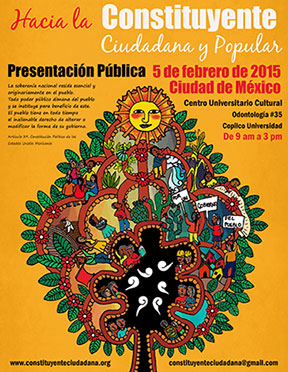 Poster announcing the
prsentation of the project for a bourgeois “Civic Constituent
Assembly,” initiated by the bishop of Saltillo, Raúl
Vera.
Poster announcing the
prsentation of the project for a bourgeois “Civic Constituent
Assembly,” initiated by the bishop of Saltillo, Raúl
Vera. The bourgeoisie is genuinely worried that the situation could spin out of control. This fear is all the more real because the PRD is utterly discredited and unable to play the role assigned to it when it arose 25 years ago: of being the bourgeois pole of a popular front to chain the workers, who were in the process of throwing off the yoke of corporatism, to a section of the capitalist class. The aim is to keep the struggles of the working people under control and to divert popular discontent into the sterile channels of parliamentary politics. For its part, the party of Andrés Manuel López Obrador, MORENA, is focused on the June 7 elections while the clamor for an electoral boycott is spreading through Guerrero and Oaxaca. And what about Mexico City?
A measure of the generalized loss of credibility of the bourgeois political system is the resignation of Cuauhtémoc Cárdenas from the PRD. The party founder complained of the “myopia, opportunism and complacency” of the party leadership. At the same time, Cárdenas advocated calling a new “Constituent Congress” to “draw up a new magna carta.” He stressed: “We are not trying to get rid of the institutions and institutional life. By no means. There is a lot that is useful, although a lot that needs to be fixed.” He only intends, he says, to “recover” the “essence of constitutionality” laid down in the constitutions of 1824, 1857 and 1917 (La Jornada, 22 November 2014).
The same tack was taken by Raúl Vera, the former curate who worked with Samuel Ruiz in San Cristóbal de las Casas (Chiapas) at the time of the Zapatista uprising and who is now the bishop of Saltillo. Vera issued a call for an assembly to “draw up a new Constitution” (Proceso, 28 December 2014). His call was joined by various well-known personalities, including the former rector of the National University, Pablo González Casanova; the poet Javier Sicilia, who in 2011 led the No Más Sangre (No More Blood) movement; and Father Solalinde, of the Casa Hermanos en el Camino (Brothers on the Road) shelter for migrants. According to Sicilia, “now is the time to refound the nation” by means of “building a new Constituent Assembly” that in turn will “articulate a Committee of National Salvation which in 2018 will become the government” (Proceso, 4 January).
The perspective of “refounding the nation” by means of a constituent assembly and a new constitution expresses the outlook of bourgeois sectors (and of “moderates” in the petty-bourgeois left which are tailing after them) who want to carry out reforms without touching the bloody roots of the Mexican regime: the capitalist system. This slogan of “refounding” the country has been popularized in Latin America in recent years above all by the bourgeois populist Evo Morales in Bolivia, and subsequently by Rafael Correa in Ecuador. In fact, Morales launched this slogan in the middle of the peasant uprising of 2003, and particularly in 2005 precisely in order to prevent a workers revolution which was literally on the doorstep.
As for the 1917 Constitution, once praised as “the most advanced in the world” at the time by those (like Adolfo Gilly) who have now declared it destroyed, this is not only the basic law of a capitalist state, its promulgation marked the consolidation of the victory of the bourgeois “Constitutionalist” army of Venustiano Carranza over the radical peasant armies of Zapata and Villa. Even its most “progressive” clauses (Article 3 on education, Article 27 on the property of land and natural resources, Article 123 on union rights) served to undercut, divert and keep under the control of the capitalist state the struggles for agrarian reform, the expropriation of oil, free education and workers’ rights.
Bourgeois ideologues have spilled rivers of ink attempting to explain the fact that in Mexico the democratic aspirations of the masses who fought in the three bourgeois-democratic revolutions that have shaped the history of the country have not been achieved. Many refer to the long (70-year) rule of the PRI-government as a “presidential” regime, which they attribute to a supposed “authoritarian” predilection among Mexicans. The writer Octavio Paz describes the PRI governments as the embodiment of a “philanthropic ogre” that bargains away democratic rights in exchange for a some paltry handouts in terms of social security of the population. The historian Enrique Krauze has come out for a “democracy without adjectives” and lambasted “ancient ideological archetypes” inherited from the colonial regime of New Spain, and even from the Aztec tlatoanis (leaders) supposedly favoring centralized states.
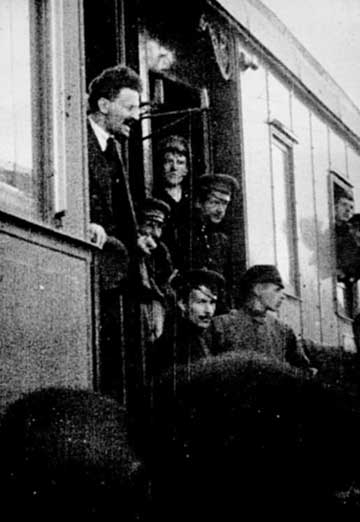 Leon Trotsky arrives in Petrograd
in May 1917. Together with Lenin, the two Bolshevik leaders
fought for "all power to the soviets," as organs of workers
power, while Stalin advocated "critical" support to the
bourgeois provisional government.
Leon Trotsky arrives in Petrograd
in May 1917. Together with Lenin, the two Bolshevik leaders
fought for "all power to the soviets," as organs of workers
power, while Stalin advocated "critical" support to the
bourgeois provisional government. But the truth is that the present situation is not derived from inveterate ideas derived from tlatoanis, viceroys or caciques (Indian chiefs). As explained by the theory of permanent revolution of Leon Trotsky, who together with Lenin led the 1917 Bolshevik Revolution in Russia, in semicolonial countries with a relatively small capitalist class, subordinated to their imperialist senior partners and surrounded by huge masses of workers and poor peasants, the weak bourgeoisie is incapable of achieving an agrarian revolution, national emancipation or democracy. It requires beefed-up measures of control in order to maintain the machinery of exploitation. Only by means of a proletarian revolution can the fundamental tasks of the bourgeois revolution be accomplished.
As Marxists we point out that democratic demands in Mexico cannot be satisfied in the framework of capitalism. The watchword of Francisco Madero, titular leader of the 1910 uprising that set off the truncated Mexican Revolution, who called for Sufragio efectivo, no reelección (“Effective Votes, No Reelection”) contrasts with Mexico today, which is the world champion in electoral fraud. Instead of Zapata’s watchword of “Land and Freedom,” we face the reality that poor peasants have been forced off their land to emigrate to the poverty belts around the big cities, or to the United States. The 19th century struggle of the liberal Mexican bourgeoisie for national independence is sharply counterposed to today’s reality of Mexico as a semi-colony of the U.S.
The one-party regime – in which the PRI fused with the state apparatus – functioned by means of a system of corporatist control fomented by Washington. The bonapartist (i.e., military/police) character of the “PRI-government,” that over time was downgraded to semi-bonapartist, kept it in power for seven decades. It could not simply be dismantled by decree. Despite the rhetoric of a “democratic transition” after 2000 and the dismantling of the state-owned industrial apparatus, the PAN governments of Vicente Fox and Felipe Calderón found they had to rely on corporatist and semi-corporatist pseudo-unions in order to impose their austerity measures and carry out their privatization programs.
The corporatist system was based on the organic integration of the workers unions and organizations of the working people (peasants, teachers, small businessmen, etc.) and all social sectors into the bourgeois state apparatus. Instead of defending the interests of the exploited and oppressed, the corporatist apparatuses carry out the functions of state control. The corporatist “unions” are in reality labor cops to hold the workers’ struggles at bay and prevent the rise of genuine workers unions.
At the same time, the corporatist system couldn’t be based exclusively on repression. It set up a system of “social security”(the Mexican Social Security Institute IMSS, the Government Employees Social Security Institute ISSSTE, the Infonavit housing projects) which offered some crumbs to the workers. Yet after a quarter century of brutal cutbacks, a privatizing offensive and the domination of the doctrines of free-trade capitalism, the threadbare web of social services is practically in ruins. The bourgeoisie is not offering more democratic concessions – on the contrary, it is bent on eliminating those that remain and increasingly resorts to blatant repression. The idea that by means of a new constitution and passing new laws the situation of the mass of the exploited and oppressed can be changed is a fraud.
Forge a Leninist-Trotskyist Party!
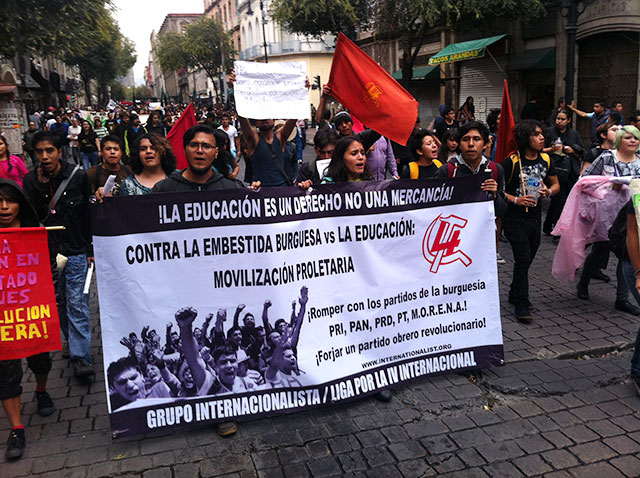
Students of the Comité Internacionalista marching with the CCH Sur (College of Science and Humanities - Souht), contingent on 2 October 2014. (Photo: Revolción Permanente)
As revolutionary Marxists, we hold – together with Lenin and Trotsky – that it can be appropriate to call for a revolutionary constituent assembly in late-developing capitalist countries where there is a military/police dictatorship and there are not even formal democratic rights for sectors of the population subject to discrimination (indigenous peoples, religious minorities, etc.). In such circumstances, the slogan can bring together oppressed sectors fighting for full democratic rights against the bourgeoisie and imperialism, and in support of the working class fighting to build organs of proletarian power, such as soviets. In that way, as an episodic tactic, it does not imply abandoning, postponing or diminishing the struggle for socialist revolution.
In Mexico, however, formal democratic rights for the population already exist. Obliged to placate the insurgent peasants and fearful of proletarian uprisings in the cities, the Mexican bourgeoisie judged it necessary to make some concessions to those sectors in the 1917 Constitution. Since those rights already exist on paper, calling for a new constituent assembly today only serves to divert the struggle. Trotskyists fight for rights such as universal access to public education at every level as well as for other rights “consecrated” in the Mexican Constitution, such as health, work and housing, while emphasizing that the full satisfaction of these elemental rights is impossible under the rule of the exploiting class.
In the face of the regime’s crisis and the urgency of presenting a genuinely revolutionary policy for a proletarian counteroffensive against decades of repressive attacks and starvation policies, the immense majority of left groups follows a diametrically counterposed policy, of class collaboration, chasing after bourgeois populist sectors. The most prominent of the supposedly socialist groups which call for a constituent assembly is the Communist Party of Mexico (Marxist-Leninist). These inveterate Stalinists have a certain influence in the CETEG, the Guerrero People’s Movement and the Popular National Assembly (ANP) formed in Ayotzinapa last October.
For the last 80 years, Stalinists of every denomination have
applied the disastrous Menshevik scheme of “two-stage”
revolution: first a bourgeois-“democratic” revolution
(anti-oligarchical, anti-imperialist, popular-democratic,
etc.), and only later a socialist stage, which never arrives.
Confronted with the irrefutable bankruptcy of the stagist
policy – which by excluding a proletarian revolution opened
the way for the victory of reactionary forces, from Franco in
Spain to Pinochet in Chile – in recent years the PCM (m-l) has
sought to don a more leftist image. Thus it proclaims that
“the character of the coming revolution will be socialist.”
But in order to cover up its real politics, it has provided
itself an escape clause: the Constituent Assembly.
In an article titled “From the Popular National Assembly to
the New Constituent Assembly” (Vanguardia Proletaria,
15-31 January), the PCM (m-l) poses the need for a “Political
General Strike” or “HPG” (according to its initials in
Spanish) to prepare “insurrectionary processes” to then
“install a revolutionary Provisional Government and convoke a
Democratic and Popular Constituent Assembly.” While it may
from time to time add the qualifier “proletarian,” it is
clearly seeking an alliance with bourgeois forces. Thus it
explicitly associates itself with the Initiative for a Popular
Civic Constituent Assembly of Vera, Solalinde and Sicilia and
their “proposal to refound the country” which has a marked
ecclesiastical, if not downright clerical, tone and purely
bourgeois liberal content.
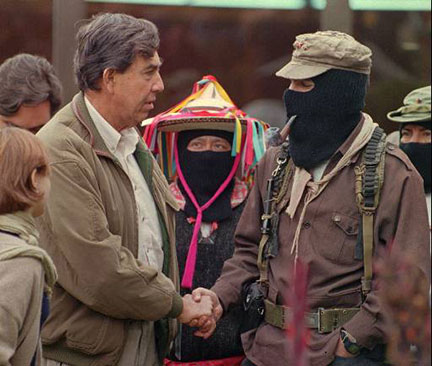 Cuauhtémoc Cárdenas, then leader of
the bourgeois PRD, meets with Zapatista Subcomandante Marcos,
in November 1996. (Photo:
Gregory Bull/AP)
Cuauhtémoc Cárdenas, then leader of
the bourgeois PRD, meets with Zapatista Subcomandante Marcos,
in November 1996. (Photo:
Gregory Bull/AP)At the same time, the PCM (m-l) continues to uphold the policy of the popular front. It cites the Democratic National Convention called by the EZLN (Zapatista National Liberation Army) in 1994, which likewise called for a “new Constituent Assembly” and which called to “vote against the system of a state party” (the PRI) and in favor of the program of the Convention, which had been endorsed by Cuautéhmoc Cárdenas, presidential candidate of the PRD. In a document titled “Two Unpostponable Tasks” (August 2014), the PCM presents as examples of a “united front” a list of popular-frontist coalitions, among them the National Front of Resistance to the Privatization of Electrical Energy, the Committee to Promote National Unity Against Neoliberalism, and others.
Following close on the heels of the Stalinists are several groups which abuse the name of Trotskyist. The Movimiento de Trabajadores por el Socialismo (MTS, Socialist Workers Movement) has in its previous incarnation as the LTS for years called not only in Mexico but all over Latin America for the slogan of a “constituent assembly.” The front page of its newspaper Tribuna Socialista (14 November 2014) proclaims, “Peña Get Out! We’re fighting for a free and sovereign constituent assembly.” Its program doesn’t go beyond a “democratic” reform of capitalism, taking up “the demands of the large majority,” “renationalization of the energy sector and privatized enterprises,” etc. A supplement (30 November) proposed:
“For our part, the MTS holds the view that a Political General Strike which turns the slogan ‘Throw them all out’ into reality, and which establishes a provisional government of the working-class, peasant and popular organizations in struggle, is the road to achieve our demands.”
In fact, the MTS places itself to the right of the reformist Stalinists of the PCM (m-l), who at least recognize that to prevail against the present bourgeois state a constituent assembly requires an insurrection and who throw in some empty rhetoric about proletarian revolution. The MTS, on the other hand, in its writings about Ayotzinapa never talks about revolution, and the only reference to socialism is its name Its policies are purely bourgeois liberal. It calls for the corrupt politicians to “get out” (que se vayan), just as Bishop Vera did in his homily of December 5. And far from calling, as the GI does, for the formation of workers and peasants councils (soviets), the MTS only speaks of “organs of direct democracy,” without any class content.
These “democraholic” social-democrats disguised as pseudo-Trotskyists are horrified by the call of authentic Trotskyists to institute a proletarian dictatorship under a workers and peasants government. To call for a constituent assembly in Mexico today is a bourgeois program to divert the potentially revolutionary struggle of the working people fed up with murderous governments. Only by raising up the great mass of the exploited and oppress can we win. Limiting oneself to “democratic” goals would be to betray the workers, peasants, students and indigenous peoples. There will not be a new edition of the Mexican Revolution of 1910-17. As we have repeated over and over, the next Mexican revolution will be a workers revolution, or it will not be.
What’s needed today is to arm the most conscious fighters with the theoretical and programmatic perspective of Trotsky’s permanent revolution, beginning with the recognition that even the most basic democratic demands are incompatible with bourgeois rule. In order to obtain them it is necessary for the working class to take power and undertake socialist tasks by abolishing bourgeois private property of the means of production and extending the revolution to the imperialist colossus of the north, with its large contingent of Mexican workers. In order to carry out this perspective today we need a Leninist-Trotskyist vanguard of the working class, a party like the Bolsheviks which takes up the defense of all the oppressed.
Intervening in the struggle of Ayotzinapa, the Grupo Internacionalista assumes as its task the forging of the nucleus of a Leninist-Trotskyist revolutionary workers party, to contribute to resolving the acute crisis of working-class leadership.
The hard truth is that without an internationalist, socialist, workers revolution, the massacres will continue. There never has been and never will be a “democratic” capitalism in Mexico. Against the bourgeois nationalist illusions in a “people united” (as in the slogan ¡Ayotzi aguanta, el pueblo se levanta!(“Hold on Ayotzinapa, the people are rising up!”) proletarian internationalists call for a policy of class struggle, ¡Luchar, vencer, obreros al poder! (“Fight to win, workers to power!”). Instead of waving the red-white-and-green Mexican tricolor flag of the mass murderers, we raise the red flag of communism. The slogan of the Grupo Internacionalista, Mexican section of the League for the Fourth International is:
¡Revolución
permanente, en todo el continente,
revolución socialista en el monstruo imperialista!
(Permanent revolution throughout the continent,
Socialist revolution inside the imperialist monster!)
Also read:
In Guerrero, the Dirty War Never Ended (February 2015)
The True “Historical Truth” of the Crime of Iguala (February 2015)
Ayotzinapa and the Imperialist Assault on Public Education (February 2015)
- 1.State Coordinating Committee of Education Workers of Guerrero, affiliated with the national CNTE, which is predominant in the state against the “institutional” corporatist pseudo-union, the SNTE. See our article, “Defend the Independent Teachers of Guerrero!”The Internationalist No. 35, Summer 2013
- 2.See “Mexico: Massacre in Iguala Calls for Mobilization and Workers Revolution,” The Internationalist No. 38, October-November 2014, some 15,000 copies of which have been distributed in the many demonstrations for Ayotzinapa.
- 3.See
“Huge
Outrage Over Guerrero Massacre,” The
Internationalist No. 38, October-November 2014.
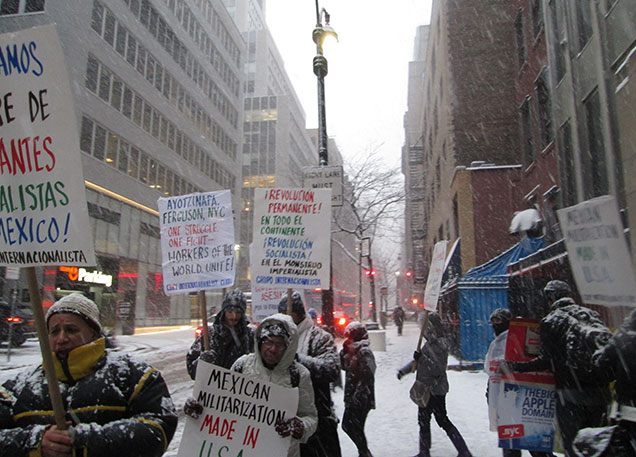
Internationalist Group/U.S. during global protest for Ayotzinapa, marching in front of Mexican consulate in New York City, 26 January 2015. (Internationalist photo)
